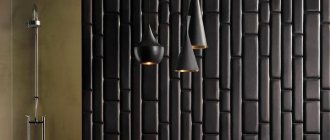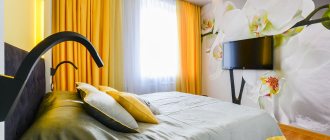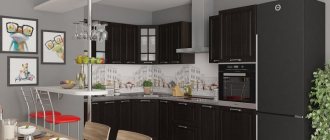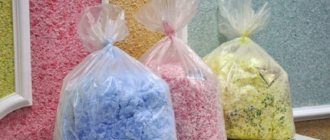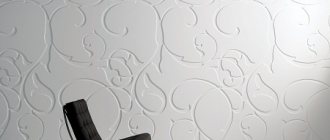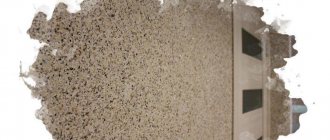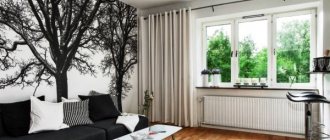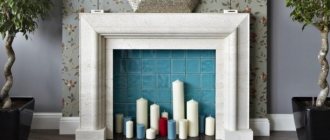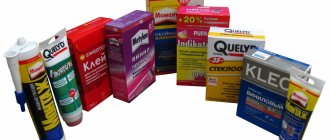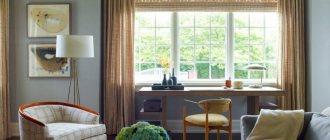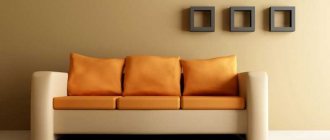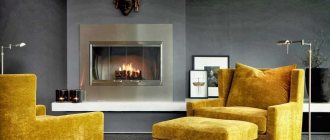Thanks to the variety of decorative materials, you can add a touch of originality and individuality to any interior. Newly invented flexible stone wallpaper , endowed with the elasticity of traditional wallpaper in combination with a unique type of stonework, recreated on the front side, can cope with this task perfectly.
Properties and characteristics
Flexible stone wallpaper is the thinnest sections of compressed stone granules (crumbs), fixed on a dense base, pre-impregnated with an elasticizing composition.
They are produced in the form of tiles, the thickness of which does not exceed 1.5 cm. The main materials for production are gypsum, sandstone or cement-gypsum mixture.
Most often, in the production of stone wallpaper, it is the gypsum base that is used - a natural material formed from sedimentary rocks.
Gypsum mixed with water is an excellent base for the manufacture of slabs of a wide variety of configurations, from standard rectangular ones to unusual elongated formats.
Casting of elements with the required configuration and geometric dimensions is carried out in polyurethane molds. Coloring agents are usually added directly to the base mass, after which it is thoroughly mixed to ensure deep coloring of the tiles.
It is worth noting that in order to give the products a more saturated color, they can be re-painted after the casting process is completed. The resulting stone wallpaper is somewhat reminiscent of ceramic tile products. The main difference is the texture of the stone.
Specifications
- thickness – 1-3 mm;
- the weight of the canvas with a thickness of 2 mm is 1.3-2.5 kg/m2;
- dimensions – 950x550 mm, 550x315 mm, 315x275, 315x138;
- temperature range of use – from +650 to -30°С;
- service life – 30 years.
Stone-effect wallpaper: advantages and disadvantages
Due to the wild success gained since its inception, stone wallpaper has its own pros and cons.
The advantages of stone wallpaper include the following:
- Due to its subtlety, stone-effect wallpaper looks very elegant and beautiful in any interior.
- Stone wallpaper is made from gypsum, which makes it lightweight. Such wallpaper can be glued using any glue or silicone.
- Stone wallpaper can be glued to putty, plaster or a painted surface.
- The gypsum stone from which wallpaper is made is absolutely safe for health.
- The wallpaper is very durable, lasts a long time, and minor scratches can always be corrected with your own hands.
The advantages of stone wallpaper are low cost, high quality and excellent durability
The wallpaper itself has no particular drawbacks. But decorative stone has them, which is very often used instead of stone wallpaper.
Disadvantages include:
- Weight of concrete tiles: they are quite heavy for modern wall materials, not everyone can withstand artificial stone;
- The rugged relief of decorative stone turns the wall into a collection of dust that is difficult to clean; in addition, concrete tiles do not add coziness to the room;
- Concrete stone is quite expensive, is not available in all stores and is very difficult to produce.
As you can see, decorating walls with artificial stone is a dubious pleasure that will do more harm than good. It is better to use wallpaper that imitates stone or a special decorative stone; it is lighter and more elegant.
Appearance
Thanks to existing technologies, tiles are produced that imitate:
- topaz;
- brick;
- sandstone;
- granite;
- slate;
- basalt;
- quartz;
- marble, etc.
The simplicity of the production process allows you to make stone wallpaper with your own hands, significantly saving money.
Types of stone wallpaper
The first gradation includes:
- Classic wallpaper intended for covering floors, walls and ceilings;
- Extra-flexible, used to add texture to steps, window sills, furniture items and other decorative elements;
- Super flexible, the main purpose of which is to texture complex surfaces.
Depending on the type of decorative effect, the coating is produced:
- With a textured relief of a pronounced character, with a depth of the relief pattern not exceeding 2 mm;
- With relief embossing combined with full-color printing;
- With optical relief, characterized by a change in the color of the wallpaper depending on exposure to sunlight;
- With a Stokes shift, visible due to the appearance of a different shade in sunlight.
- Self-luminous;
- With fluorescence imaging;
- With a change in shade depending on changes in room temperature;
- With mother-of-pearl tints, onyx effect or the now very popular opalescence effect.
Where is it used?
It must be said that the scope of application of decorative stone in the interior of premises for various purposes is quite wide. You can place decorative stone, especially in addition to other materials, in many places. Here is just a short list of rooms and premises:
- Hallway.
- Living room.
- Kitchen.
- Bedroom.
- Loggia.
- Retail premises.
- Halls and foyers of office buildings.
Depending on what exactly the buyer/customer likes best, various options for decorating the interior space of the hallway and other rooms with stone can be used:
- As the main finishing material.
- As one of the auxiliary coatings when combining different types of finishes.
In addition, in addition to wall decor, artificial stone has another opportunity for use in the interior of rooms. We are talking about finishing the ceilings, usually partial. It is used as an additional measure to give the room a more finished look. Of course, it is difficult to imagine the ceiling of a room being completely finished using stone finishing. However, if we talk about fragmentary use, then it is quite acceptable.
Attention! Do not forget that different materials must be successfully combined, including color.
Almost everyone knows that stone finishing does not suffer from fungus or mold, unlike some other types of finishing coatings, and is also not afraid of corrosion or mechanical damage. In addition, this material, which can be used as a companion when finishing interior walls and partitions, is also distinguished by the fact that it is able to provide the highest level of environmental safety. This makes it possible to place such material in any living room, since it is absolutely safe for human health: both adults and children.
Scope of application
Stone wallpaper, the price of which varies from 500 to 2000 rubles. per m2, are characterized by a fairly wide range of applications. This:
- interior wall decoration;
- façade cladding;
- finishing of curved and other complex bases;
- decorating fireplace portals, furniture facades, countertops, floor coverings, etc.;
- production of decorative stone frescoes or panels;
- use as a basis for window blinds.
Common varieties
Considering the main types of finishing stone, it should be noted that they are somewhat different from each other. What exactly is the difference between them? One of the classifications is based on the origin of a particular material. So, the stone can be either natural or artificial. We will now provide a brief description of the characteristics and features of each of these types.
Fake diamond
Recently, the use of artificial stone to decorate the walls of rooms has become increasingly common. It can be used either alone or in combination with wallpaper. The growing popularity is by no means accidental, since it is due to numerous advantages. Let's list the main advantages:
- Inexpensive in price.
- It is light in weight compared to its natural “brothers”.
- Strong and durable.
Of course, artificial stone must be produced on the basis of some kind of raw material, which, in turn, is of natural origin. In most cases, cement or gypsum is used as the base. Gypsum tiles have their advantages and disadvantages, just like any other material. On the one hand, it is characterized by excellent aesthetic characteristics, which makes this material very attractive. It can be used in the hall and bedroom. On the other hand, installing this type of finishing in the corridor, as well as in the loggia and toilet (you can read about wallpaper in the toilet in more detail in this article) may raise certain questions, because withstanding high levels of moisture is not one of its strengths.
On the other hand, decorative cement stone is more resistant to use in rooms with higher moisture levels. Therefore, this coating can be safely used in the hallway, kitchen, dining room and even in the bathroom.
Imitation of other materials
Any artificial coating has one feature: it is designed, to one degree or another, to imitate one of the natural materials. Artificial stone for interior decoration is no exception. Thanks to the variety of various options offered by various manufacturers, buyers have the opportunity to select the necessary finishing surfaces for almost any interior style. In addition, we must not forget about the many possibilities for combining in the interior. Wallpaper (vinyl, paper, non-woven and other types) can also act as companions, of course.
Let's look at the most popular "samples" for copying:
- Slate. An interesting material with a unique surface allows you to create very unusual interiors, as well as combinations. Due to its appearance, the illusion of a uniform surface is created.
- Natural stone. Perhaps the most popular type of imitation. As a matter of fact, this is why the material acquired its name: artificial STONE.
- Ceramic clinker brick. The tile, which is designed to imitate real brick, can be painted in any color. In addition, its texture can also be different: from completely smooth, to rough and slightly “aged”. By the way, artificially aged materials are often used in the Provence style, which you can learn more about by reading this material.
Natural materials
So, before answering the question of whether it is possible to glue decorative stone to wallpaper, let's look at the types of materials that are of natural origin and were not made artificially from one or another raw material. A special feature of this type of wall decoration is the significant cost of both the material itself and the work required to install it correctly and beautifully. In addition, unlike some artificial analogues, it is characterized by considerable weight, which makes transporting and laying such stone more difficult tasks.
There are 4 main materials of natural origin:
- The easiest way to do the installation yourself is in cases where you use sandstone. Its common colors are green, yellowish, brown, beige, red.
- A more expensive and heavier stone that suits a more formal style is granite.
- Similar words can be said about marble, which is the optimal solution for classic interiors.
- And finally, limestone. It is, in some ways, similar to sandstone, due to its relatively simple installation and lighter weight compared to granite and marble.
Interesting to know! This material is also known as “wild stone”.
Advantages and disadvantages
Flexible stone wallpaper for interior decoration is universal, temperature-resistant, suitable for decorating any interior items and premises, from living rooms to kitchens, balconies and terraces.
They are also used for facade work, for finishing gazebos and verandas. Stone wallpaper in the interior looks great thanks to the variety of textures and colors. Imitation of the most unusual reliefs, differences and original smoothed and sharp corners significantly expand the possibilities of application.
They are uniquely flexible, as a result of which elements can be easily mounted on complex foundations with various unevenness or differences.
Along with resistance to temperature effects due to the non-flammability of gypsum, stone tiles are 100% waterproof and do not absorb moisture or steam, thereby eliminating the possibility of increasing humidity in the room due to the formation of dampness.
Also, the excellent moisture resistance of the material indicates its practicality. Caring for decorative coating is simple and comes down to periodic wet cleaning with a damp cloth or sponge.
To achieve the best effect, it is allowed to use non-aggressive detergents. Aggressive compounds can seriously damage the surface, discoloring it.
Since gypsum, when heated, does not emit any harmful or toxic substances, flexible stone wallpaper is rightfully recognized as environmentally friendly.
Another feature of gypsum stone wallpaper is its thermal conductivity of 0.1 W, which, of course, does not classify it as an excellent thermal insulator, however, even this value is enough to save precious heat in the room.
It is impossible not to note the phenomenal density and strength of the wallpaper. This indicates not only excellent resistance to mechanical stress, but also the resistance of the tiles to abrasion, which determines their durability.
The service life of the highest quality non-woven fabrics does not exceed 20 years, but here the manufacturers guarantee 30 years.
Impeccable external characteristics are the next advantage. A variety of shades, textures and reliefs allow you to choose a laconic option for any stylistic direction of the room and add originality and nobility to the interior. The possibility of combination with other decors allows you to emphasize the individuality of the finish.
Installing stone wallpaper is a completely feasible task for doing it yourself. Most of all, the installation process is similar to finishing with ceramic tiles, but in a much simplified manner.
The need for careful adjustment of elements is eliminated; it is enough to maintain the correct horizontal and vertical lines. They are easy to process. They can be sawed, adjusted, trimmed and sanded, and their low thickness makes the task even easier.
Flaws
The price for stone wallpaper is an order of magnitude higher than the cost of the most expensive fiberglass or non-woven fabrics today. The high cost is precisely the first disadvantage.
The second is the fragility of the tiles. The material tolerates transportation especially poorly, so craftsmen advise purchasing 15% more than the calculated quantity.
Features and benefits of the combination
Recently, decorating the hallway with decorative stone and wallpaper has become fashionable. This solution is considered the latest trend in design. This combination of materials unusually emphasizes the geometry of the space and gives the room a sophisticated and rich look. It should be noted that the technology of such finishing is simple, and a huge selection of wallpaper and stone allows you to satisfy the most varied tastes of the owners. Rolled materials with stone patterns, complemented by plaster imitations, look especially original on the walls.
Today, most designers recommend decorating hallways in an unusual way, covering the walls with wallpaper and decorative stone. Thanks to this unusual combination, you can achieve a stunning effect in the interior. This finishing method can be used not only in the hallway, but also in the hallway, as it looks beautiful and fits any style.
In addition, the walls after decoration are easy to maintain and have high wear resistance. Before starting work, you will need to correctly calculate the configuration of the walls, the level of lighting and the size of the room, because in a small hallway, such decoration will make the room smaller, and special framing of the openings with mirrors can visually expand the space.
The main advantages of this combination include:
- harmonious combination with other types of finishes. Stone can be complemented not only with wallpaper, but also with tiles, wood or plaster.
- Huge selection of colors, textures and shapes.
- Stylish and respectable look.
- Excellent performance characteristics.
- Ease of work. Anyone can paste wallpaper and cover it with stone.
When choosing this type of finishing, you should take into account the harmony of the colors of the canvas and decorative stone. For example, using light colors, you can achieve a good visual effect and increase the volume of the hallway, while dark colors will make the room richer and brighter.
You can combine wallpaper with both natural and artificial stone.
